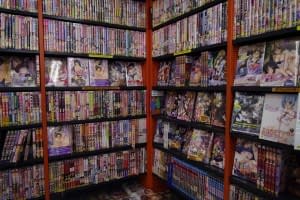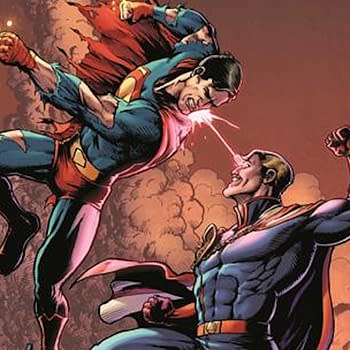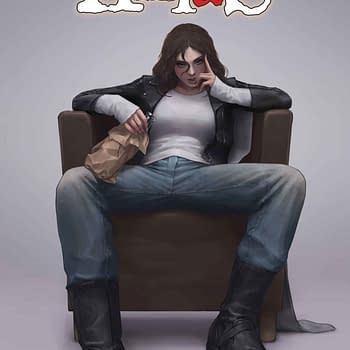Posted in: Recent Updates | Tagged:
Britain's "Child Images" Legislation Comes Into Effect

Part of this bill is an extension of possession of prohibited images of children – this essentially extends laws from images to pseudo-imagery.
There have been a number of examples of this form of legislation being introduced (or trying to be) in a number of countries, Britain is one of the few where this law has been passed successfully.
Here's the relevant language in question. It may be worth checking as to whether it applies to any items in your comic book collection.
Chapter 2 Images of children
Prohibited images
62 Possession of prohibited images of children Show EN
(1) It is an offence for a person to be in possession of a prohibited image of a child.
(2) A prohibited image is an image which—
(a) is pornographic,
(b) falls within subsection (6), and
(c) is grossly offensive, disgusting or otherwise of an obscene character.
(3) An image is "pornographic" if it is of such a nature that it must reasonably be assumed to have been produced solely or principally for the purpose of sexual arousal.
(4) Where (as found in the person's possession) an image forms part of a series of images, the question whether the image is of such a nature as is mentioned in subsection (3) is to be determined by reference to—
(a) the image itself, and
(b) (if the series of images is such as to be capable of providing a context for the image) the context in which it occurs in the series of images.
(5) So, for example, where—
(a) an image forms an integral part of a narrative constituted by a series of images, and
(b) having regard to those images as a whole, they are not of such a nature that they must reasonably be assumed to have been produced solely or principally for the purpose of sexual arousal,
the image may, by virtue of being part of that narrative, be found not to be pornographic, even though it might have been found to be pornographic if taken by itself.
(6) An image falls within this subsection if it—
(a) is an image which focuses solely or principally on a child's genitals or anal region, or
(b) portrays any of the acts mentioned in subsection (7).
(7) Those acts are—
(a) the performance by a person of an act of intercourse or oral sex with or in the presence of a child;
(b) an act of masturbation by, of, involving or in the presence of a child;
(c) an act which involves penetration of the vagina or anus of a child with a part of a person's body or with anything else;
(d) an act of penetration, in the presence of a child, of the vagina or anus of a person with a part of a person's body or with anything else;
(e) the performance by a child of an act of intercourse or oral sex with an animal (whether dead or alive or imaginary);
(f) the performance by a person of an act of intercourse or oral sex with an animal (whether dead or alive or imaginary) in the presence of a child.
(8) For the purposes of subsection (7), penetration is a continuing act from entry to withdrawal.
(9) Proceedings for an offence under subsection (1) may not be instituted—
(a) in England and Wales, except by or with the consent of the Director of Public Prosecutions;
(b) in Northern Ireland, except by or with the consent of the Director of Public Prosecutions for Northern Ireland.
63 Exclusion of classified film etc Show EN
(1) Section 62(1) does not apply to excluded images.
(2) An "excluded image" is an image which forms part of a series of images contained in a recording of the whole or part of a classified work.
(3) But such an image is not an "excluded image" if—
(a) it is contained in a recording of an extract from a classified work, and
(b) it is of such a nature that it must reasonably be assumed to have been extracted (whether with or without other images) solely or principally for the purpose of sexual arousal.
(4) Where an extracted image is one of a series of images contained in the recording, the question whether the image is of such a nature as is mentioned in subsection (3)(b) is to be determined by reference to—
(a) the image itself, and
(b) (if the series of images is such as to be capable of providing a context for the image) the context in which it occurs in the series of images;
and section 62(5) applies in connection with determining that question as it applies in connection with determining whether an image is pornographic.
(5) In determining for the purposes of this section whether a recording is a recording of the whole or part of a classified work, any alteration attributable to—
(a) a defect caused for technical reasons or by inadvertence on the part of any person, or
(b) the inclusion in the recording of any extraneous material (such as advertisements),
is to be disregarded.
(6) Nothing in this section is to be taken as affecting any duty of a designated authority to have regard to section 62 (along with other enactments creating criminal offences) in determining whether a video work is suitable for a classification certificate to be issued in respect of it.
(7) In this section—
- "classified work" means (subject to subsection (8)) a video work in respect of which a classification certificate has been issued by a designated authority (whether before or after the commencement of this section);
- "classification certificate" and "video work" have the same meaning as in the Video Recordings Act 1984 (c. 39);
- "designated authority" means an authority which has been designated by the Secretary of State under section 4 of that Act;
- "extract" includes an extract consisting of a single image;
- "pornographic" has the same meaning as in section 62;
- "recording" means any disc, tape or other device capable of storing data electronically and from which images may be produced (by any means).
(8) Section 22(3) of the Video Recordings Act 1984 (effect of alterations) applies for the purposes of this section as it applies for the purposes of that Act.
64 Defences Show EN
(1) Where a person is charged with an offence under section 62(1), it is a defence for the person to prove any of the following matters—
(a) that the person had a legitimate reason for being in possession of the image concerned;
(b) that the person had not seen the image concerned and did not know, nor had any cause to suspect, it to be a prohibited image of a child;
(c) that the person—
(i) was sent the image concerned without any prior request having been made by or on behalf of the person, and
(ii) did not keep it for an unreasonable time.
(2) In this section "prohibited image" has the same meaning as in section 62.
65 Meaning of "image" and "child" Show EN
(1) The following apply for the purposes of sections 62 to 64.
(2) "Image" includes—
(a) a moving or still image (produced by any means), or
(b) data (stored by any means) which is capable of conversion into an image within paragraph (a).
(3) "Image" does not include an indecent photograph, or indecent pseudo-photograph, of a child.
(4) In subsection (3) "indecent photograph" and "indecent pseudo-photograph" are to be construed—
(a) in relation to England and Wales, in accordance with the Protection of Children Act 1978 (c. 37), and
(b) in relation to Northern Ireland, in accordance with the Protection of Children (Northern Ireland) Order 1978 (S.I. 1978/1047 (N.I. 17)).
(5) "Child", subject to subsection (6), means a person under the age of 18.
(6) Where an image shows a person the image is to be treated as an image of a child if—
(a) the impression conveyed by the image is that the person shown is a child, or
(b) the predominant impression conveyed is that the person shown is a child despite the fact that some of the physical characteristics shown are not those of a child.
(7) References to an image of a person include references to an image of an imaginary person.
(8) References to an image of a child include references to an image of an imaginary child.
66 Penalties Show EN
(1) This section has effect where a person is guilty of an offence under section 62(1).
(2) The offender is liable—
(a) on summary conviction, to imprisonment for a term not exceeding the relevant period or a fine not exceeding the statutory maximum, or both;
(b) on conviction on indictment, to imprisonment for a term not exceeding 3 years or a fine, or both.
(3) "The relevant period" means—
(a) in relation to England and Wales, 12 months;
(b) in relation to Northern Ireland, 6 months.
67 Entry, search, seizure and forfeiture Show EN
(1) The following provisions of the Protection of Children Act 1978 (c. 37) apply in relation to prohibited images of children as they apply in relation to indecent photographs of children (within the meaning of that Act)—
(a) section 4 (entry, search and seizure);
(b) the Schedule (forfeiture of photographs).
(2) The following provisions of the Protection of Children (Northern Ireland) Order 1978 (S.I. 1978/1047 (N.I. 17)) apply in relation to prohibited images of children as they apply in relation to indecent photographs of children (within the meaning of that Order)—
(a) Article 4 (entry, search and seizure);
(b) the Schedule (forfeiture of photographs).
(3) In this section "prohibited image of a child" means a prohibited image of a child to which section 62(1) applies.
68 Special rules relating to providers of information society services Show EN
Schedule 13 makes special provision in connection with the operation of section 62(1) in relation to persons providing information society services within the meaning of that Schedule.
Indecent pseudo-photographs of children
69 Indecent pseudo-photographs of children: marriage etc Show EN
(1) In section 1A of the Protection of Children Act 1978 (c. 37) (making of indecent photograph of child etc: marriage and other relationships), after "photograph", in each place it occurs, insert "or pseudo-photograph".
(2) In section 160A of the Criminal Justice Act 1988 (c. 33) (possession of indecent photograph of child etc: marriage and other relationships), after "photograph", in each place it occurs, insert "or pseudo-photograph".
(3) In Article 15A of the Criminal Justice (Evidence, etc) (Northern Ireland) Order 1988 (S.I. 1988/1847 (N.I. 17)) (marriage and other relationships), after "photograph", in each place it occurs, insert "or pseudo-photograph".
(4) In Article 3B of the Protection of Children (Northern Ireland) Order 1978 (S.I. 1978/1047 (N.I. 17)) (marriage and other relationships), after "photograph", in each place it occurs, insert "or pseudo-photograph".
Whether or not this covers the like of Alan Moore and Melinda Gebbie's Lost Girls, on many a comic book reader's bookshelves is debatable. But this will most definitely affect the "lolicon" form of manga, volumes of which are imported into the UK from Japan and sold by a number of mainstream bookstores.











